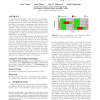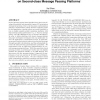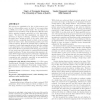ICS
2005
Tsinghua U.
14 years 5 months ago
2005
Tsinghua U.
As parallel jobs get bigger in size and finer in granularity, “system noise” is increasingly becoming a problem. In fact, fine-grained jobs on clusters with thousands of SMP...
ICS
2005
Tsinghua U.
14 years 5 months ago
2005
Tsinghua U.
Excessive power consumption is becoming a major barrier to extracting the maximum performance from high-performance parallel systems. Therefore, techniques oriented towards reduci...
ICS
2005
Tsinghua U.
14 years 5 months ago
2005
Tsinghua U.
Previous studies have shown that array regrouping and structure splitting significantly improve data locality. The most effective technique relies on profiling every access to eve...
ICS
2005
Tsinghua U.
14 years 5 months ago
2005
Tsinghua U.
Several message passing-based parallel solvers have been developed for general (non-symmetric) sparse LU factorization with partial pivoting. Due to the fine-grain synchronizatio...
ICS
2005
Tsinghua U.
14 years 5 months ago
2005
Tsinghua U.
Chip Multiprocessors (CMPs) are flexible, high-frequency platforms on which to support Thread-Level Speculation (TLS). However, for TLS to deliver on its promise, CMPs must explo...
ICS
2005
Tsinghua U.
14 years 5 months ago
2005
Tsinghua U.
As network traffic continues to increase and with the requirement to process packets at line rates, high performance routers need to forward millions of packets every second. Eve...
ICS
2005
Tsinghua U.
14 years 5 months ago
2005
Tsinghua U.
Supercomputer architects strive to maximize the performance of scientific applications. Unfortunately, the large, unwieldy nature of most scientific applications has lead to the...
ICS
2005
Tsinghua U.
14 years 5 months ago
2005
Tsinghua U.
Traditionally, scheduling in high-end parallel systems focuses on how to minimize the average job waiting time and on how to maximize the overall system utilization. Despite the d...
ICS
2005
Tsinghua U.
14 years 5 months ago
2005
Tsinghua U.
We propose an organization for the on-chip memory system of a chip multiprocessor, in which 16 processors share a 16MB pool of 256 L2 cache banks. The L2 cache is organized as a n...
ICS
2005
Tsinghua U.
14 years 5 months ago
2005
Tsinghua U.



